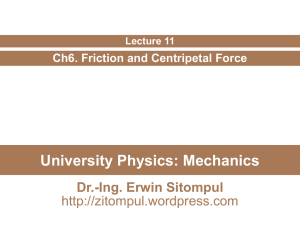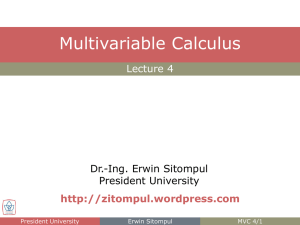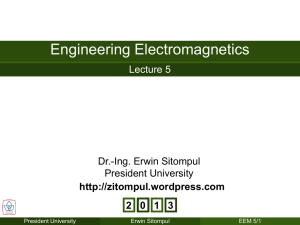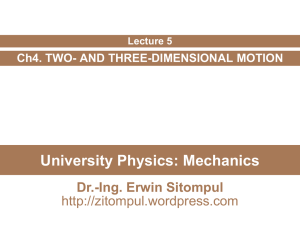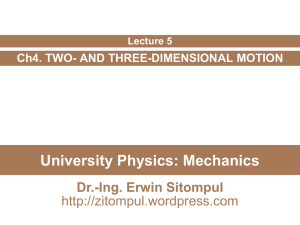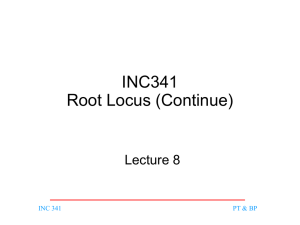s - Erwin Sitompul
advertisement
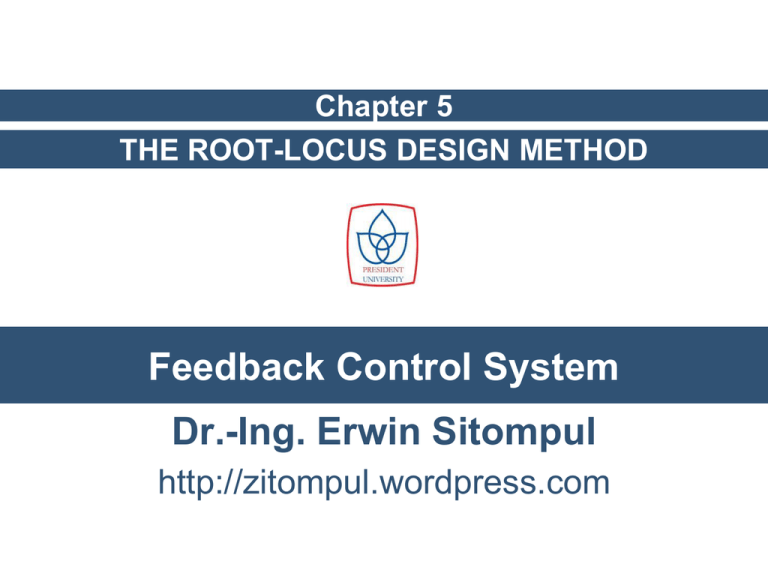
Chapter 5 THE ROOT-LOCUS DESIGN METHOD Feedback Control System Dr.-Ing. Erwin Sitompul http://zitompul.wordpress.com Example 3: Plotting a Root Locus Now, sketch the root locus for: s 1 1 K 2 0 s ( s 4) L( s ) s 1 s 2 ( s 4) n 3, m 1 z1 1, p1,2 0, p3 4 Erwin Sitompul RULE 1 • There are 3 branches of locus. • Two starting from s = 0 and one from s = –4. • There will be two zeros at infinity. Feedback Control System 7/2 Example 3: Plotting a Root Locus z1 1, p1,2 0, p3 4 3 Imag axis 2 1 RULE 2 –4 –3 –2 –1 0 1 2 Real axis –1 –2 –3 Erwin Sitompul Feedback Control System 7/3 Example 3: Plotting a Root Locus 180 360(l 1) l nm 180 360(l 1) 3 1 90 180(l 1) 90, 270 p z i nm 4 (1) 3 1 1.5 Erwin Sitompul i Angles of Asymptotes z1 1, p1,2 0, p3 4 Center of Asymptotes Feedback Control System 7/4 Example 3: Plotting a Root Locus 90° l 90, 270 1.5 3 Imag axis 2 1 –4 –3 –2 –1 0 –1 RULE 4 Not applicable. The angles of departure or the angles of arrival must be calculated only if there are any complex poles or zeros. Erwin Sitompul 1 2 Real axis RULE 3 –2 270° –3 Feedback Control System 7/5 Example 3: Plotting a Root Locus 1 KL(s) 0 s 1 1 K 2 0 s ( s 4) s3 4s 2 Ks K 0 Replacing s with jω0, ( j0 )3 4( j0 )2 K ( j0 ) K 0 j03 402 jK0 K 0 K 4 j(K0 ) 0 2 0 ≡0 3 0 ≡0 K 402 K0 03 K 02 K 0, 0 0 Points of Cross-over Erwin Sitompul Feedback Control System 7/6 Example 3: Plotting a Root Locus 3 K 0, 0 0 Imag axis 2 RULE 5 1 –4 –3 –2 –1 0 1 2 Real axis –1 –2 –3 Erwin Sitompul Feedback Control System 7/7 Example 3: Plotting a Root Locus 1 KL(s) 0 b( s ) s 1 s 1 L( s ) 2 3 a( s) s ( s 4) s 4s 2 The root locus must have a break-away point, which can be found by solving: da ( s ) db( s ) b( s ) a(s) 0 ds ds (s 1) (3s2 8s) (s3 4s2 ) 1 0 3s3 11s 2 8s 0 s3 4s 2 0 2s3 7s 2 8s 0 s1 0, s2,3 1.75 j0.9682 Erwin Sitompul Feedback Control System 7/8 Example 3: Plotting a Root Locus s1 0, s2 1.75 j 0.9682 On the root locus The break-away point 3 Not on the root locus 2 1 –4 –3 Imag axis –2 –1 0 0 1 RULE 6 2 Real axis –1 –2 –3 Erwin Sitompul Feedback Control System 7/9 Example 3: Plotting a Root Locus After examining RULE 1 up to RULE 6, now there is enough information to draw the root locus plot. 3 2 90 1 –4 –3 Imag axis –2 –1 0 0 1 2 Real axis –1 –2 –3 Erwin Sitompul Feedback Control System 7/10 Example 3: Plotting a Root Locus The final sketch, with direction of root movements as K increases from 0 to ∞ can be shown as: 3 Imag axis Final Result 2 1 –4 –3 –2 –1 0 1 2 Real axis –1 –2 –3 Erwin Sitompul Feedback Control System 7/11 Example 4: Plotting a Root Locus Now, the characteristic equation is changed a little bit: s 1 1 K 2 0 s ( s 9) L( s ) s 1 s 2 ( s 9) n 3, m 1 z1 1, p1,2 0, p3 9 Erwin Sitompul RULE 1 • There are 3 branches of locus. • Two starting from s = 0 and one from s = –9. • There will be two zeros at infinity. Feedback Control System 7/12 Example 4: Plotting a Root Locus z1 1, p1,2 0, p3 9 3 Imag axis 2 1 RULE 2 –9 –4 –3 –2 –1 0 1 2 Real axis –1 –2 –3 Erwin Sitompul Feedback Control System 7/13 Example 4: Plotting a Root Locus 180 360(l 1) l nm 180 360(l 1) 3 1 90 180(l 1) 90, 270 p z i nm 9 (1) 3 1 4 Erwin Sitompul i Angles of Asymptotes z1 1, p1,2 0, p3 9 Center of Asymptotes Feedback Control System 7/14 Example 4: Plotting a Root Locus l 90, 270 4 90° 3 Imag axis 2 1 –9 –4 –3 –2 –1 0 –1 1 2 Real axis RULE 3 –2 RULE 4 270° –3 Not applicable. Erwin Sitompul Feedback Control System 7/15 Example 4: Plotting a Root Locus 1 KL(s) 0 s 1 1 K 2 0 s ( s 9) s3 9s 2 Ks K 0 Replacing s with jω0, ( j0 )3 9( j0 )2 K ( j0 ) K 0 j03 902 jK0 K 0 K 9 j(K0 ) 0 2 0 ≡0 3 0 ≡0 K 902 K0 03 K 02 K 0, 0 0 Points of Cross-over Erwin Sitompul Feedback Control System 7/16 Example 4: Plotting a Root Locus 3 K 0, 0 0 Imag axis 2 RULE 5 1 –9 –4 –3 –2 –1 0 1 2 Real axis –1 –2 –3 Erwin Sitompul Feedback Control System 7/17 Example 4: Plotting a Root Locus 1 KL(s) 0 b( s ) s 1 s 1 L( s ) 2 3 a( s) s ( s 9) s 9s 2 The root locus must have a break-away point, which can be found by solving: da ( s ) db( s ) b( s ) a(s) 0 ds ds (s 1) (3s 2 18s) (s3 9s 2 ) 1 0 3s3 21s 2 18s 0 s3 9s 2 0 2s3 12s 2 18s 0 s1 0, s2,3 3 Erwin Sitompul Feedback Control System 7/18 Example 4: Plotting a Root Locus s1 0, s2,3 3 3 On the root locus At the same time, the break-in and the break-away point On the root locus –3 The break-away point –9 –4 –3 –2 Imag axis 2 RULE 6 1 –1 0 0 1 2 Real axis –1 –2 –3 Erwin Sitompul Feedback Control System 7/19 Example 4: Plotting a Root Locus After examining RULE 1 up to RULE 6, now there is enough information to draw the root locus plot. 3 2 –3 90 –9 –4 –3 Imag axis –2 –1 1 0 0 1 2 Real axis –1 –2 –3 Erwin Sitompul Feedback Control System 7/20 Example 4: Plotting a Root Locus The final sketch, with direction of root movements as K increases from 0 to ∞ can be shown as: 3 Imag axis Final Result 2 1 –9 –4 –3 –2 –1 0 1 2 Real axis –1 –2 –3 Erwin Sitompul Feedback Control System 7/21 Conclusion: Example 3 and Example 4 s 1 1 K 2 0 s ( s 4) s 1 1 K 2 0 s ( s 9) The characteristic equations can be so similar, yet the resulting root locus plots are very different. It is very important to examine each rule carefully. Erwin Sitompul Feedback Control System 7/22 The Effect of Adding Poles to a System 1.5 0.1 0.05 5 0 Imag Axis 0.5 Imag Axis Imag Axis α = –2 1 0 -0.5 -0.05 -3 -2 Real Axis L( s ) -1 1 ( s 1) 0 0 -5 -1 -0.1 α = –3 -1.5 -3 -2 L( s ) Real Axis -1 1 ( s 1)( s 3) 0 -10 -5 Real Axis 0 1 L( s ) ( s 1)( s 3)( s 5) If a pole is added to a system: The root locus is pulled to the right. The stability tends to decrease. The settling time tends to increase (for the same value of ζ, the value of ωd decreases). Erwin Sitompul Feedback Control System 7/23 The Effect of Adding Zeros to a System L( s ) Imag Axis 5 1 ( s 1)( s 3)( s 5) If a zero is added to a system: The root locus is pulled to the left. The stability tends to increase. The settling time tends to decrease (for the same value of ζ, the value of ωd increases). 0 -5 -10 -5 Real Axis 0 10 α = –1.5 8 6 8 α = –2.5 6 4 2 0 -2 2 Imag Axis Imag Axis 4 Imag Axis α = –3.5 6 4 0 -2 2 0 -2 -4 -4 -4 -6 -6 -8 -6 -8 -10 -6 -5 -4 -3 Real Axis -2 -1 0 -5 -4.5 -4 -3.5 -3 -2.5 -2 Real Axis -1.5 -1 -0.5 0 -5 -4.5 -4 -3.5 -3 -2.5 -2 -1.5 -1 -0.5 0 Real Axis ( s 6) ( s 4) ( s 2) L( s ) L( s ) L( s ) ( s 1)( s 3)( s 5) ( s 1)( s 3)( s 5) ( s 1)( s 3)( s 5) Erwin Sitompul Feedback Control System 7/24 Design Using Dynamic Compensation If the process dynamics are of such a nature that a satisfactory design cannot be obtained by adjustment of K alone, then some modification or compensation of the process dynamics must be done. Two compensation schemes have been found to be particularly simple and effective: Lead compensation, approximates the function of PD control and acts mainly to speed up a response by lowering the rise time and decreasing the transient overshot. Lag compensation, approximates the function of PI control and is usually used to improve the steady-state accuracy of the system. The techniques to select the parameters of each compensation schemes will be discussed now. Erwin Sitompul Feedback Control System 7/25 Design Using Dynamic Compensation A compensation scheme is written generally in the form of a transfer function: sz D( s ) K s p If z < p, it is called lead compensation. If z > p, it is called lag compensation. The characteristic equation of the system is: 1 D(s)G(s) 0 1 KL(s) 0 Erwin Sitompul Feedback Control System 7/26 Design Using Lead Compensation Consider a second-order position control system with normalized transfer function: 1 G( s) s( s 1) The root locus of the system will be compared for: D1 (s) K s2 D2 ( s ) K s 10 s2 D3 ( s ) K s 20 Erwin Sitompul Feedback Control System 7/27 Design Using Lead Compensation 0.5 5 15 α = –0.5 10 α = –4.5 α = –9.5 4 3 0 Imag Axis Imag Axis Imag Axis 2 5 0 -5 0 -1 -2 -10 -3 -4 -15 -0.5 1 -5 -1 -0.8 -0.6 -0.4 Real Axis -0.2 0 -10 -8 -6 -4 Real Axis -2 0 -20 -18 -16 -14 -12 -10 -8 -6 -4 -2 0 s2 s2 D2 ( s ) K D3 ( s ) K D1 (s) K s 10 s 20 Selecting the value of z and p is usually done by trial and error, which can be minimized with experience. In general, the zero is placed near the closed-loop ωn, as determined by time domain specification, the pole is located at a distance 5 to 20 times the value of the zero location. If the pole is too far to the right, the root locus moves back too far toward its uncompensated shape, while if the pole is too far the left, sensor noise will be amplified too much. Erwin Sitompul Real Axis Feedback Control System 7/28 First Design Using Lead Compensation Find a compensation for G(s) = 1/[s(s+1)] that will provide overshoot of no more than 20% and rise time of no more than 0.25 sec. 1 1 sin sin 0.456 (ln M p ) 2 2 (ln 0.2) 2 2 0.208 2 2 2 (ln M p ) (ln 0.2) 0.473 0.208 0.456 tr d d 2 tr 2.044 d 8.176 2.044 9.187 8.176, n d 2 2 0.25 1 1 0.456 Erwin Sitompul Feedback Control System 7/29 First Design Using Lead Compensation Giving grid to the root locus plot of using D2(s)G(s), and using the calculation results: Area of Eligible Roots 0.456 10 0.64 0.8 Imag Axis 5 0.94 0.5 10 0.38 0.28 0.170.088 6 4 2 0 n 9.187 For K 100, s2,3 4.396 j8.4413 n (4.396) 2 (8.4413) 0.94 -5 0.8 -10 -10 0.64 -8 Erwin Sitompul 2 4 6 0.5 0.38 0.28 0.170.088 100 -6 -4 -2 Real Axis 9.517 rad s 4.396 0.462 9.517 Design requirement fulfilled with: D2 ( s) 100 s2 s 10 Feedback Control System 7/30 Second Design Using Lead Compensation The closed-loop system of G(s) = 1/[s(s+1)] is now required to have a pole at r0 3.5 j3.5 3 (corresponds to ωn = 7 and ζ = 0.5). sz Now using D3 ( s ) K , the value of K and z must be s 20 determined. 1 s = –z Erwin Sitompul • There is exactly one location for the zero where the angle ψ1 will fulfill the phase condition of r0. • If the zero is placed on that location, r0 will be on the root locus. Feedback Control System 7/31 Second Design Using Lead Compensation 1 tan1 (3.5 3 16.5) 20.174 1 1 2 3 tan1 (3.5 3 2.5) 2 112.411 3 tan1 (3.5 3 3.5) 120 i i 1 1 2 3 180 360(l 1) 1 20.174 112.411 120 180 360(l 1) 1 252.585 180 360(l 1) 1 72.585 Erwin Sitompul Feedback Control System 7/32 Second Design Using Lead Compensation r0 3.5 j3.5 3 The position of the zero can now be calculated: tan 72.585 3.5 3 (3.5 ( z)) 3.188 3.5 3 3.5 3.188 5.402 z 3.188 Solving for K using the characteristic equation, 1 1 D3 (s)G(s) 0 s = –z 1 72.585 s 5.402 1 1 K s 20 s( s 1) s 3.5 j 3.5 0 3 1.902 j3.5 3 1 1 K 0 16.5 j3.5 3 (3.5 j3.5 3)(2.5 j3.5 3) Erwin Sitompul Feedback Control System 7/33 Second Design Using Lead Compensation 1 K 1.902 j3.5 3 1 16.5 j3.5 3 3.5 j3.5 3 (2.5 j3.5 3) 0 6.3536 1 1 K 0 17.5784 7 6.5574 K 126.996 127 r0 Thus, the compensation that will make r0 3.5 j3.5 3 to be on the root locus is: s 5.402 D3 ( s ) 127 s 20 Erwin Sitompul r0 Feedback Control System 7/34 Design Using Lag Compensation Once satisfactory dynamic response has been obtained, perhaps by using one or more lead compensations, we may discover that the low-frequency gain (the value of the relevant steady-state error constant, such as Kv, Ka) is still too low. In order to increase this constant, it is necessary to do so in a way that does not upset the already satisfactory dynamic response. The new compensation D(s) should yield a significant gain at s = 0 to raise the steady-state error constant but is nearly unity at the higher frequency ωn. The result is: sz , z p D( s ) K s p The value of z and p are small compared with ωn, yet D(0) = z / p can be adjusted to be big enough to adjust the steady-state gain. Erwin Sitompul Feedback Control System 7/35 Design Using Lag Compensation To study the effects of lag compensation, we use again the result of the “Second Design Using Lead Compensation”. The uncompensated closed-loop system is: G(s) = 1/[s(s+1)] It is required to have a pole at r0 3.5 j3.5 3 (corresponds to ωn = 7 and ζ = 0.5). The obtained lead compensation is D(s) = 127(s+5.402)/(s+20). At the operating point, the velocity constant is given by: s 5.402 1 K v lim s L s lim s 127 s 0 s 0 s 20 s( s 1) 34.30 • Suppose not big enough • Required Kv = 100 Erwin Sitompul Feedback Control System 7/36 Design Using Lag Compensation To obtain Kv = 100, an additional lag compensation is designed, with: z/p = 3 to increase the velocity constant by 3 at s = 0. a pole at p = –0.01 to keep the values of both z and p very small so that the lag compensation would have little effect around ωn = 7, the dominant dynamics already obtained previously by the lead compensation. The overall open-loop transfer function with lead-lag compensation is now given by: L(s) Dlag (s) Dlead (s) G(s) s 0.03 s 5.402 1 127 s 0.01 s 20 s( s 1) • Remark: The design using lag compensation is performed after adjusting the gain K and performing the design using lead compensation(s) Erwin Sitompul Feedback Control System 7/37 Design Using Lag Compensation The root locus of the new L(s) is plotted below. Dominant root, hardly affected The root locus near the lag compensation The transient response corresponding to the lagcompensation zero will be very slowly decaying, with small magnitude, and might seriously influence the settling time. The lag pole-zero combination must be placed at the highest frequency possible without shifting the dominant roots. Erwin Sitompul Feedback Control System 7/38 Example: Compensation Design Problem 5.24 FPE Let G( s) sa 1 and D( s ) K sb ( s 2)( s 3) Using root-locus techniques, find values for the parameters a, b, and K of the compensation D(s) that will produce closedloop poles at s =–1 ± j for the system shown below. Unity Feedback System Erwin Sitompul Feedback Control System 7/39 Example: Compensation Design Before compensation 1 L( s ) G ( s ) ( s 2)( s 3) 3 Imag axis desired closedloop poles 2 1 –4 –3 –2 –1 0 1 2 Real axis –1 –2 –3 Erwin Sitompul Feedback Control System 7/40 Example: Compensation Design 3 Imag axis desired closedloop poles 2 The zero of D(s) cancels the pole of G(s) –4 1 –3 –2 –1 0 –2 Erwin Sitompul 2 –1 : roots of the compensation s3 D( s ) K s L( s) D( s)G( s) K 1 Real axis –3 The pole of D(s) is placed in such a way that the desired closed loop poles are on the future root locus 1 s( s 2) Feedback Control System 7/41 Example: Compensation Design 1 L( s ) K s( s 2) 3 Imag axis 2 1 –4 : roots of the compensation –3 –2 –1 0 1 2 Real axis –1 –2 –3 Erwin Sitompul Feedback Control System 7/42 Example: Compensation Design 1 L( s ) K s( s 2) 3 Imag axis 2 K? 1 –4 –3 –2 –1 0 1 2 Real axis –1 –2 –3 Erwin Sitompul Feedback Control System 7/43 Example: Compensation Design Solving for K using the characteristic equation, 1 L(s) 0 1 1 K 0 s( s 2) K s(s 2) K s(s 2) s1 j (1 j)(1 j) 2 The compensation D(s) can now completely be written as: s3 D( s ) 2 s Erwin Sitompul Feedback Control System 7/44 Homework 7 No.1, FPE (5th Ed.), 5.23. No.2, FPE (5th Ed.), 5.30. No.3 Consider the unity feedback system, with: K G( s) ( s 3)( s 5) (a) Show that the system cannot operate with a 2%-settlingtime of 2/3 second and a percent overshoot of 1.5% with a simple gain adjustment. (b) Design a lead compensator so that the system meets the transient response characteristics of part (a). Specify the compensator’s pole, zero, and the required gain. Erwin Sitompul Feedback Control System 7/45
